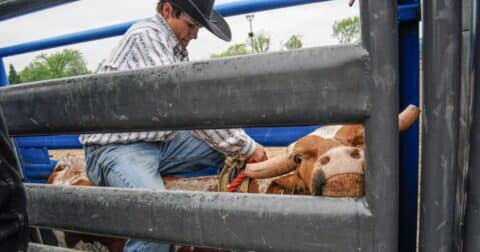News
GLP-1 Users Lose Weight, and Their Taste for Meat
Research•3 min read
Feature
Some forms of animal entertainment are going out of style, but rodeos persist.


Words by Jessica Scott-Reid
Today, rodeos big and small draw crowds across North America. Spectators looking to indulge in cowboy culture gather to watch man versus beast in a display of traditional ranching skills and techniques. Whether it’s a small town gathering, a massive event for millions or a traveling show not unlike the circus or professional wrestling, rodeos have evolved over time into a popular spectacle.
But the trend is not without controversy.
At the center of rodeos are of course the animals — horses, calves, steers, sheep, pigs and more — who are raced, chased, wrestled and roped. Some of these animals become injured. Some die. Yet the crowds keep coming. What is it about rodeos that continue to attract a certain sector of people, despite (or because of) the common occurrence of what others deem animal cruelty? And why, when some forms of animal entertainment are falling out of cultural favor (like wild animal circus, whale and dolphin shows), do rodeos continue to be popular?
Experts tell us there is much psychology at play, along with cultural identity — and even a connection to diet.
The roots of rodeo in North America can be traced back to Spanish colonization in the 16th century, when vaqueros, or cowboys, introduced their cattle-handling skills. This evolved into informal contests among ranch workers, eventually integrating Indigenous horsemanship. By the late 19th century, rodeos became formalized as popular events, leaving behind a complex legacy of cultural exchange amid colonization’s many impacts on Indigenous peoples and lands.
Today, rodeos have become a contentious topic. As proponents work to maintain tradition, and corporate sponsors work to maintain big profits, animal advocates protest and lobby to get these shows shut down. “Traditional ranch work has been perverted into a spectacle of animal abuse disguised as ‘western tradition,’” states advocacy group Showing Animals Respect and Kindness (SHARK), in a report published by Encyclopedia Britannica. “Modern rodeos are cruel and deadly for animals.”
Deeply steeped in Western cowboy culture and agricultural traditions, rodeos are promoted as exhibitions of ranching talents and techniques. But according to animal advocates, these contests cause animals tremendous stress, injuries and death, in the name of mere entertainment. This polarizing perception has led to an increase in protests at rodeo events, with activists, and even some lawmakers, calling for them to be banned.
One of the biggest and most well-known rodeos in the U.S. today is Cheyenne Frontier Days. The 127-year-old event attracts around 250,000 or more visitors to Wyoming annually, with an increase in attendance to rodeo events last year.
The Calgary Stampede, which has taken place in Alberta, Canada since 1912, brought in a record attendance of nearly 1.5 million people in July 2024, reportedly generating $540 million Canadian dollars for the province, and $282 million for the local economy. (Though it also cost Canadian taxpayers $10 million to help the event “bounce back” from the COVID19 pandemic.)
Since 1986, when the Vancouver Humane Society began keeping a record of deaths at the Calgary stampede, 109 animals have lost their lives. The majority have been horses killed due to injuries sustained in the notoriously violent — albeit profitable — chuckwagon races. Other animals have died from traumatic injuries such as broken necks or heart failure.
There does not appear to be any recent record of animal deaths at Cheyenne Frontier Days, but that doesn’t mean no animals were harmed. “Cheyenne quit releasing injury and death numbers about 10 years ago,” Mike Kobliska of the group SHARK tells Sentient. “They used to release those statistics to the media after the rodeo every year, but they now keep that number secret,” he says. A news report from 2013 states that at least six animals died during the 10-day event that year.
The international Professional Bull Riders, or PBR league (which performs at Cheyenne Frontier Days), was established in the early 1990s, and travels throughout the U.S., Canada, Brazil and Australia. The show garners extensive television coverage in addition to in-person attendees. “Five PBR events on CBS in 2023 topped 1 million viewers heading into the finals,” notes The Athletic.
While a tally of animal deaths for the Professional Bull Riders’ many leagues does not appear available, numerous animal advocacy groups have called out the event in various locations for instances of animal cruelty. This includes bulls being forced to endure spurs, flank straps and other agitating techniques causing discomfort and stress, as well as loud and startling pyrotechnics.
“Rodeo is a dangerous competition. Animals are going to get hurt,” writes Will Carpenter for the Wyoming Tribune Eagle. “The nature of the sport is violent, and there’s no avoiding the inherent danger.”
According to the Animal Legal Defense Fund, rodeo events including calf roping, bull riding, steer wrestling, chuckwagon racing and others have caused animals to suffer “broken ribs, backs, and legs, torn tails, punctured lungs, internal organ damage, ripped tendons, torn ligaments, snapped necks, and agonizing deaths.”
So what draws millions of people to witness these events, given the documented harm to animals? Philip Tedeschi is a clinical professor at the University of Denver, and an expert in the human-animal connection. He argues that when it comes to understanding rodeo spectators, context is key.
“When we start to look at the nature of human-animal interaction, one of the things that we have been able to document is that the information people have is often manipulated,” he tells Sentient, “or not very accurate, about what’s going on with animals.” Regarding rodeos, he says, if a person is brought up since childhood to believe that what they are observing is “a game or sport,” something “culturally defined as a deserving activity,” it becomes normalized. This is especially true when that practice is further reinforced with praise and recognition. “Often this socialization, that cultural framework, is embedded in that culture at almost every level, from very early child development,” he says.
We see this in rodeo activities geared specifically toward children, such as “pig scrambles” and “mutton busting.” In these events children ride sheep or other animals, “or engage in wrestling an animal or controlling them in some form,” Tedeschi describes, “and then getting a lot of attention for that. This is early shaping of those behaviors.” Organizations like 4H and Future Farmers of America similarly serve to socialize children to emotionally distance themselves from the animals they are tasked to care for, before selling them to be slaughtered, and these same organizations are also often present at rodeos.
These behaviors are then reinforced by rodeo; “seeing people earning lots of money and being stars and getting a lot of recognition for it,” says Tedeschi, “framing it as some kind of accomplishment.” Being recognized for the “accomplishment” of overpowering an animal then aids in the creation of personal identity — which leads to membership into a broader cultural identity, of someone who attends rodeo.
The strong connection to cultural identity helps explain why rodeos endure. While other forms of animal entertainment, such as circuses and marine parks, have been steadily falling out of public favor across North America in recent years, rodeos continue to be popular.
Dr. Sherman Lee, a professor of psychology at Christopher Newport University, explains that while rodeos are very much rooted in culture, other forms of animal entertainment are not. “If I’m going to go somewhere like SeaWorld, and they’re closed, that’s not a part of my cultural identity,” Lee tells Sentient. “That’s not something necessarily tied to my roots or history. It’s got nothing to do with my occupation.” Ultimately, fighting against those forms of animal entertainment turns out to be far easier than the fight to end rodeos.
Tedeschi, on the other hand, sees rodeos’ stronghold a bit differently. In the case of marine animals, “we started to see attention paid to the sentience of those other animals, whales in particular, and dolphins and some of the other cetaceans,” he says, both in the media and culture at large. This allows more of the general public to see their suffering, and to be on board with calling for it to end. But farm animals and even horses tend to fall into a different category, because they are consumed or used in the farming of animals for food.
“It’s incentivized by the livestock industries and the food industries to continue to promote these animals as consumptive,” says Tedeschi, “as material items that can be bought and sold, that have no legal standing, and are genuinely considered just property […] a food source.” This, he says, is “the contributing factor to the dismissiveness of their sentient experience.” This, he believes, is a big reason why rodeos persist.
Adding to this dismissiveness is also the way injured, dead and dying animals are handled at rodeos. “They’ll disguise or cover up or hide damages done to individual animals,” Tedeschi says, pointing to instances of rodeo staff quickly covering up an injured animal with a tarp to illustrate. “They’ll distract the audience from that,” he says, even though spectators know these incidents are, as he describes, “a kind of planned collateral damage.” This practice of “making sure people don’t have that as the defining memory,” adds Tedeschi, “shows quite a lot of complicity, or at least culpability” on the part of the rodeo.
There has been some progress in improving animal welfare in the rodeo world. According to the Wyoming Tribune Eagle report on improvements at Cheyenne Frontier Days, in 2008 the event banned the use of cattle prods and other stimulating devices in chutes. Water misters have also reportedly been added to “better prevent any horses or bulls from experiencing a heat stroke.”
Events encouraging children to tackle animals have also been banned or otherwise canceled.
And jerk-downs, “an illegal move used in tie-down roping that sees the competitor give some slack, then snap the animal back, harmfully jerking the calf in the air by the neck, were outlawed by the Professional Rodeo Cowboys Association in 2012.”
Despite these improvements, rodeo events remain as popular as ever with fans. Both the Calgary Stampede and Cheyenne Frontier Days saw an increase in attendance this year. Even as marine parks and circuses close amid declining public interest, rodeos seem to remain untouchable.